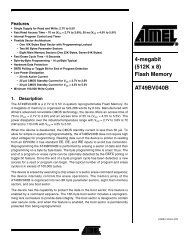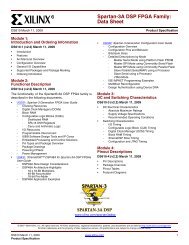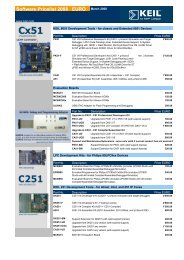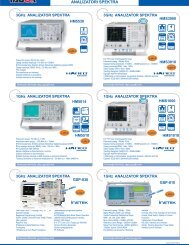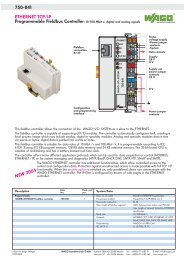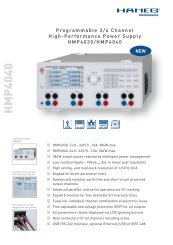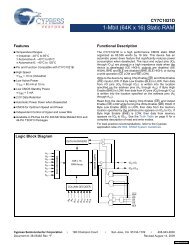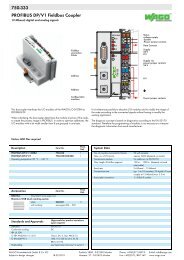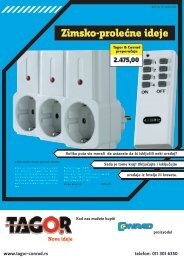PIC12F683 Data Sheet - Microchip
PIC12F683 Data Sheet - Microchip
PIC12F683 Data Sheet - Microchip
You also want an ePaper? Increase the reach of your titles
YUMPU automatically turns print PDFs into web optimized ePapers that Google loves.
<strong>PIC12F683</strong><br />
12.7 Power-Down Mode (Sleep)<br />
The Power-down mode is entered by executing a<br />
SLEEP instruction.<br />
If the Watchdog Timer is enabled:<br />
• WDT will be cleared but keeps running.<br />
• PD bit in the STATUS register is cleared.<br />
• TO bit is set.<br />
• Oscillator driver is turned off.<br />
• I/O ports maintain the status they had before SLEEP<br />
was executed (driving high, low or high-impedance).<br />
For lowest current consumption in this mode, all I/O pins<br />
should be either at VDD or VSS, with no external circuitry<br />
drawing current from the I/O pin and the comparators<br />
and CVREF should be disabled. I/O pins that are<br />
high-impedance inputs should be pulled high or low<br />
externally to avoid switching currents caused by floating<br />
inputs. The T0CKI input should also be at VDD or VSS for<br />
lowest current consumption. The contribution from<br />
on-chip pull-ups on GPIO should be considered.<br />
The MCLR pin must be at a logic high level.<br />
Note:<br />
It should be noted that a Reset generated<br />
by a WDT time-out does not drive MCLR<br />
pin low.<br />
12.7.1 WAKE-UP FROM SLEEP<br />
The device can wake-up from Sleep through one of the<br />
following events:<br />
1. External Reset input on MCLR pin.<br />
2. Watchdog Timer wake-up (if WDT was<br />
enabled).<br />
3. Interrupt from GP2/INT pin, GPIO change or a<br />
peripheral interrupt.<br />
The first event will cause a device Reset. The two latter<br />
events are considered a continuation of program<br />
execution. The TO and PD bits in the STATUS register<br />
can be used to determine the cause of a device Reset.<br />
The PD bit, which is set on power-up, is cleared when<br />
Sleep is invoked. TO bit is cleared if WDT wake-up<br />
occurred.<br />
The following peripheral interrupts can wake the device<br />
from Sleep:<br />
1. Timer1 interrupt. Timer1 must be operating as<br />
an asynchronous counter.<br />
2. ECCP Capture mode interrupt.<br />
3. A/D conversion (when A/D clock source is FRC).<br />
4. EEPROM write operation completion.<br />
5. Comparator output changes state.<br />
6. Interrupt-on-change.<br />
7. External Interrupt from INT pin.<br />
Other peripherals cannot generate interrupts since<br />
during Sleep, no on-chip clocks are present.<br />
When the SLEEP instruction is being executed, the next<br />
instruction (PC + 1) is prefetched. For the device to<br />
wake-up through an interrupt event, the corresponding<br />
interrupt enable bit must be set (enabled). Wake-up<br />
occurs regardless of the state of the GIE bit. If the GIE<br />
bit is clear (disabled), the device continues execution at<br />
the instruction after the SLEEP instruction. If the GIE bit<br />
is set (enabled), the device executes the instruction<br />
after the SLEEP instruction, then branches to the interrupt<br />
address (0004h). In cases where the execution of<br />
the instruction following SLEEP is not desirable, the<br />
user should have a NOP after the SLEEP instruction.<br />
Note:<br />
If the global interrupts are disabled (GIE is<br />
cleared) and any interrupt source has both<br />
its interrupt enable bit and the corresponding<br />
interrupt flag bits set, the device will<br />
immediately wake-up from Sleep.<br />
The WDT is cleared when the device wakes up from<br />
Sleep, regardless of the source of wake-up.<br />
12.7.2 WAKE-UP USING INTERRUPTS<br />
When global interrupts are disabled (GIE cleared) and<br />
any interrupt source has both its interrupt enable bit<br />
and interrupt flag bit set, one of the following will occur:<br />
• If the interrupt occurs before the execution of a<br />
SLEEP instruction, the SLEEP instruction will<br />
complete as a NOP. Therefore, the WDT and WDT<br />
prescaler and postscaler (if enabled) will not be<br />
cleared, the TO bit will not be set and the PD bit<br />
will not be cleared.<br />
• If the interrupt occurs during or after the<br />
execution of a SLEEP instruction, the device will<br />
Immediately wake-up from Sleep. The SLEEP<br />
instruction is executed. Therefore, the WDT and<br />
WDT prescaler and postscaler (if enabled) will be<br />
cleared, the TO bit will be set and the PD bit will<br />
be cleared.<br />
Even if the flag bits were checked before executing a<br />
SLEEP instruction, it may be possible for flag bits to<br />
become set before the SLEEP instruction completes. To<br />
determine whether a SLEEP instruction executed, test<br />
the PD bit. If the PD bit is set, the SLEEP instruction<br />
was executed as a NOP.<br />
To ensure that the WDT is cleared, a CLRWDT instruction<br />
should be executed before a SLEEP instruction. See<br />
Figure 12-10 for more details.<br />
DS41211D-page 98<br />
© 2007 <strong>Microchip</strong> Technology Inc.



